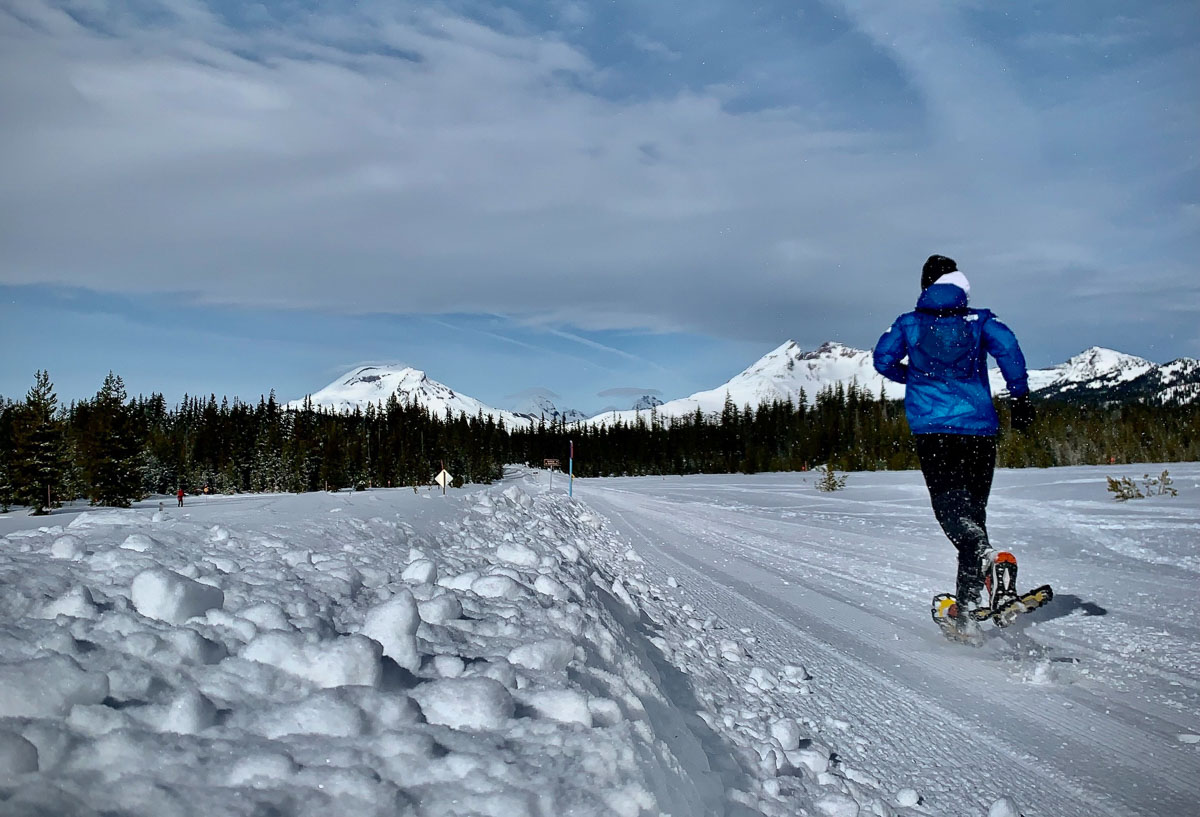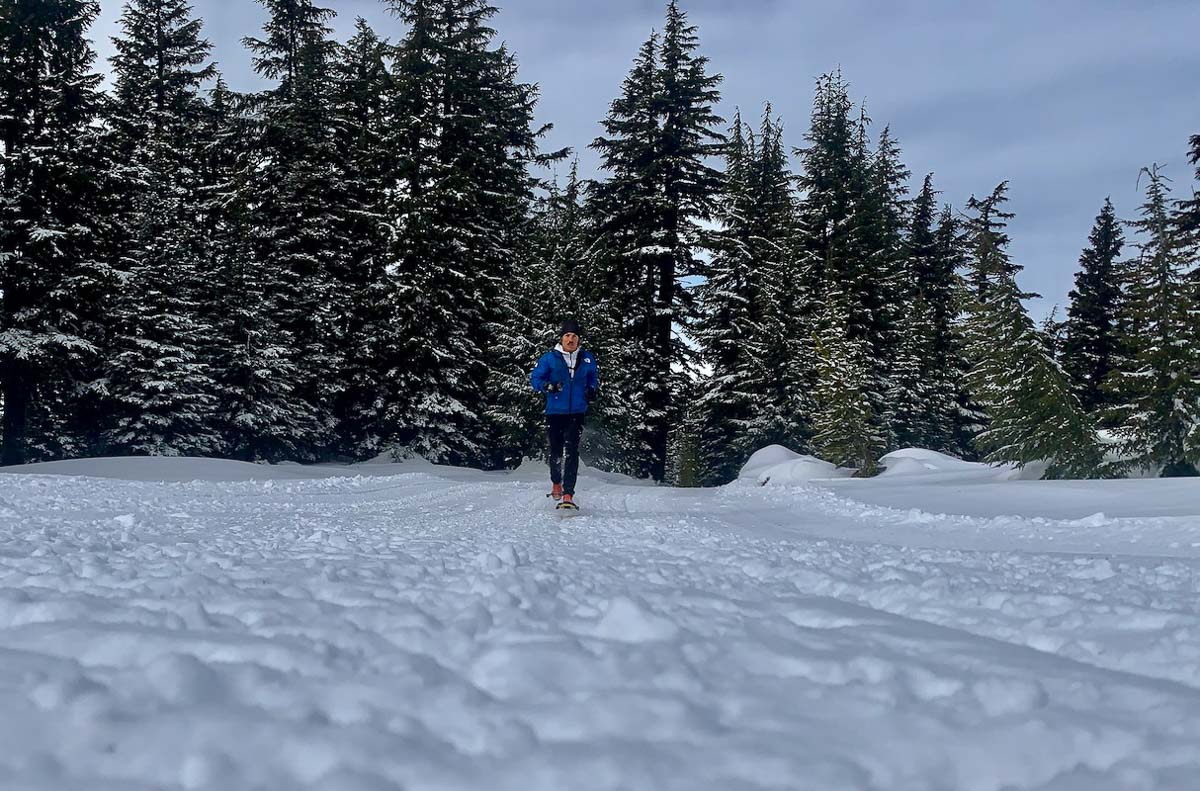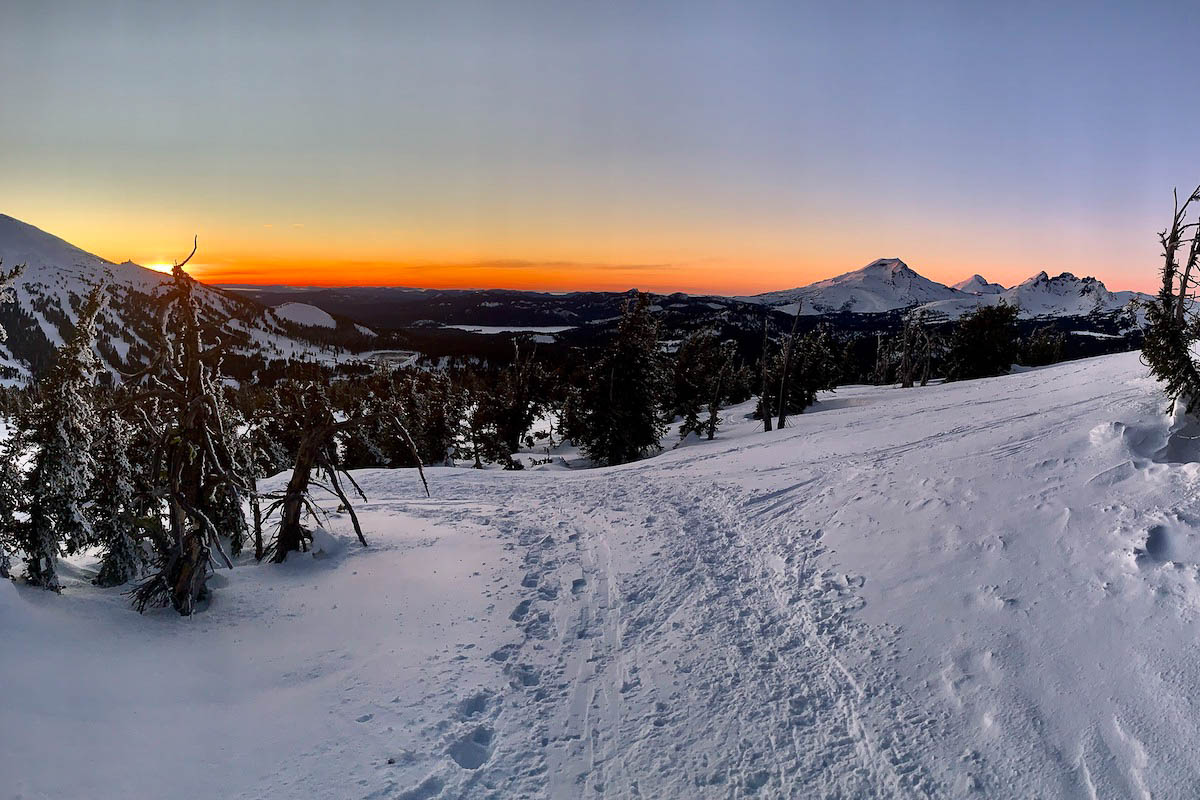Snowshoe running is a weird sport. Essentially, it is what trail running is to road running, meaning it’s the fringe of the fringe. Snowshoe running is strange and quirky; there don’t seem to be many people who do it, and even though I’m a fan of the sport, I’ll admit, it does feel a bit foolish.
The first time I ever snowshoe ran I probably wore shorts. Don’t get me wrong. There are certainly some spring-like days when snowshoe running in shorts is entirely acceptable. But even a cold-weather shorts wearer like myself has to admit that most of the time, it’s a terrible idea. Snowshoe running in shorts is like riding a mountain bike through the mud in a Speedo swimsuit with no mudguard. Basically, it’s just a huge mess, and a cold one at that.

Zach Miller bundled up while snowshoe running with mountains in the distance. All photos: Zach Miller
Snowshoes, which help to keep you atop the snow, are also really good at moving the snow from beneath you to straight up your backside. This is especially the case when the snow is fresh. It’s like running inside a self-induced blizzard. Needless to say, I learned to cover my legs.
Even when you cover your legs (and hands, neck, head, and pretty much every other piece of skin), snowshoe running is still kind of miserable. The surface, unless hard-packed or frozen solid, runs a lot like beach sand. Say goodbye to that smooth, efficient stride that we all strive for during a run.
When the surface is hard-packed, you tend to go faster, but you also tend to find yourself trading efficiency for pressure points. That soft surface that once cushioned each footfall and gently accepted the metal crampons of your snowshoes now pushes back, and pushes back harshly. Sure, it’s bearable, but kind of on the level of ill-fitted ski boots. Everyone grins like a fool amid the fun, but breathes a collective sigh of relief when those soul-crushing demons come off.
To top it all off, 90% of the time, it isn’t even fast. For all of the effort put into it, it produces a rather disappointing amount of zoomies.
So, why do it? Well, for one, I actually do think it’s fun. But I’m also a bit of a masochist, so you can take that with a grain of salt. Second, and this one is hard to deny, is that the forests, mountains, and trails are incredibly beautiful when blanketed in snow. That reason is totally legit, as is the third, which is the fitness gain snowshoe running brings.
A few weeks ago, I was out snowshoeing one of my usual trails when I made a remarkable discovery. The trail I was on was one that I always ran at night, meaning all I could ever really see was what lay within the reach of my headlamp.
On this particular day, however, I was running at sunset. As I ascended the biggest climb of the route, one which I usually admire for the steep grade and inherent training benefit, I caught a glimpse of what lay behind me.
There in the distance, a space typically cloaked in darkness, was a beautiful view of Broken Top, an iconic peak here in the Cascade Range of Oregon. I was so surprised when I saw it. It had been there all along. Every night I trudged up this climb in darkness, it was right there, and yet I never saw it. It made me think.
I thought of how training is like this. So much of our off-season, winter training is spent in the trenches. The sessions aren’t always overly interesting. Oftentimes they are a lot of the same stuff over and over again. Building the engine by gradually ramping up the volume, and developing strength is the name of the game. It can feel monotonous and draining.
On top of that, many of us quietly set about our work in the dark. No epic sunrises, soothing sunsets, or breathtaking views. Just the pounding of our feet and the heaving of our lungs. With time, it can take its toll.
Life can feel the same. Like the soft snow beneath a snowshoe, we go through periods of slow struggle. And as with the hardpack, there are moments that jar us like the harsh underside of a crampon. But like the winter, these difficult times have their limit, and with time, better days emerge.
In training, as the snow melts and the snowshoes come off, we segue to faster workouts and eventually races. It is here that we reap the benefits of a hard winter’s work. The grind of the winter is like that climb I did time and again in the dark. The reward was right there — we just couldn’t see it yet.
It’s mid-February now and the almighty Pennsylvania groundhog has called for 6 more weeks of winter. Perhaps you feel as though you’ve had enough. You want warm sun, dry trails, and smooth sailing, but don’t bail yet.
This long and dark climb is important. It doesn’t go on forever. It helps us get to the top, where the fruits of our labor, though out of sight for the time being, will one day be brought to light.
Call for Comments
- Do you do some alternative training to help get you through the winter? Snowshoeing, perhaps?
- What do you do when the long winter months just feel like a slog without improvement?


